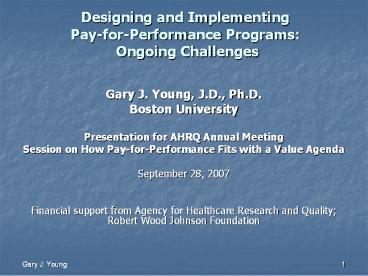Designing and Implementing Pay-for-Performance Programs: Ongoing Challenges - PowerPoint PPT Presentation
Title:
Designing and Implementing Pay-for-Performance Programs: Ongoing Challenges
Description:
Designing and Implementing Pay-for-Performance Programs: Ongoing Challenges Gary J. Young, J.D., Ph.D. Boston University Presentation for AHRQ Annual Meeting – PowerPoint PPT presentation
Number of Views:113
Avg rating:3.0/5.0
Title: Designing and Implementing Pay-for-Performance Programs: Ongoing Challenges
1
Designing and ImplementingPay-for-Performance
Programs Ongoing Challenges
- Gary J. Young, J.D., Ph.D.
- Boston University
- Presentation for AHRQ Annual Meeting
- Session on How Pay-for-Performance Fits with a
Value Agenda - September 28, 2007
- Financial support from Agency for Healthcare
Research and Quality Robert Wood Johnson
Foundation
2
P4P Will it Work?
- Recent evidence points to modest gains from P4P
in terms of provider adherence. - Selected Findings
- Rosenthal et al. (2006) Relative increase of 3.6
percentage points for cervical cancer screening - Levin-Scherz et al. (2006)
- Relative increase of 2-19
percentage points for diabetes measures - Lindenauer et a. (2007) CMS Premier
demonstration Relative increase of 2.6
percentage points for AMI measures 3.4 points
for pneumonia measures 4.1 points for heart
failure measures. - Young et al. (2007)
- Absolute increase of 7 percentage points for
diabetes measure (e.g., eye exam)
3
Key Challenges
- Provider Engagement
- Unit of Accountability
- Quality Measures
- Provider Capability
- Incentive Structure
- Data Systems and Measurement
- Unintended Consequences
4
Supporting Research
- 7 Demonstration Sites Rewarding Results
- Surveys of Physicians (over 4000 surveyed
approximately 1500 responses) - Interviews with over 60 Senior Managers
- of Physician Organizations
- Focus Groups with Providers and Payers
- Site Visits to Provider Organizations
- Findings of Other Researchers
5
Provider Engagement
- Physicians appear comfortable with the concept of
P4P. - --Strong preference for incentives linked to
quality vs. utilization or productivity
6
Survey Results
7
Survey Results
8
Provider Engagement
- Physicians do not appear to have a strong
understanding of the P4P programs in which they
participate. Conventional forms of communicating
w/ providers appear inadequate (very Low
physician survey scores regarding understanding
of programs). - Many physicians appear to feel disenfranchised.
Physician involvement in program design can help
secure buy-in (e.g., selection/modification of
measures).
9
Unit of Accountability
- Sponsors face difficult choices and possible
tradeoffs between selecting individuals versus
organizations. - -- systems engineering vs. physician
initiative - -- stimulating investment in QI infrastructure
vs. enhancing engagement of front-line
providers.
10
Quality Measures
- Physicians generally comfortable with
standardized measures such as HEDIS and HQA. - --Outcomes vs. Process Measures
- --Specialists and Non-Acute Care Settings
11
Provider Capability
- Providers reveal anxiety about capabilities to
perform well on quality measures. - --Hospitals with well developed QI
infrastructure appeared to have a distinct
advantage in BCBSM P4P - With limited provider capability, one-time
performance gains may be common. - --In some situations, learning goals should
possibly precede performance goals
12
(No Transcript)
13
Incentive Structure
- Both program sponsors and providers are divided
on many issues regarding incentive structure. - --Attainment vs. Improvement
- --Bonus only vs. Penalties (e.g.,
withholds)
14
Data Systems and Measurement
- Providers have strong concerns about data
reliability and validity. - --Claims vs. Charts (appeals process/reserve
fund) - -- Small Numbers (composite scores
- multi-payer initiatives)
15
Unintended Consequences
- Physician surveys reveal no major concerns about
UC. - --Some studies outside healthcare point to
negative impact on innovation. - -- P4P in safety net settings may pose unique
risks.
16
Concluding Comments
- P4P can lead to gains in clinical quality, but
the magnitude of the gains may be quite modest
and time-limited, particularly without
substantial improvements in provider
infrastructure for quality measurement and
improvement. - Physicians do appear comfortable with P4P as a
concept, but have certain concerns with the way
P4P programs have been designed and implemented. - Program sponsors face many daunting challenges in
designing and implementing programs.































